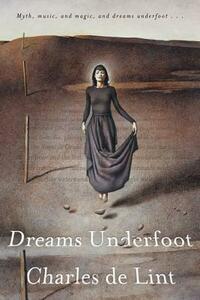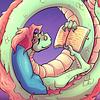Take a photo of a barcode or cover
This book was absolutely beautiful to start with, and slowly dragged itself down from a five star to a four star rating for me. Dreams Underfoot is a series of short stories occurring to a small group of people, and it reads like a modern day, more adult urban fantasy Hans Christian Anderson or Brothers Grimm book of myths. Everyone who has talked books with me knows how I love a good myth. There's three ways this book falls flat; otherwise, I would be cramming it down everyone's throat.
Firstly, by being a book of short stories about interconnected people, the feeling of whim and delight fades about halfway through. See, there's pluses and minuses to having continued characters - the plus is a more rounded, realized narrative and the sensation that everything matters. The downside is that you lose a lot of that whimsical, first time glee of having magic just out the corner of your eye when it's constantly Jilly or Geordie or Christie's eye.
Secondly, the story Time Skip is just phenomenal, but it happens so early on in the book that the next few stories will just fall flat, and it never really hits as hard as that one story again. There's cool and unique and fantastic and sad things all throughout, but nothing's going to be like Time Skip again. Especially later on in the book, when de Lint decided to write a conclusion to the original story that falls flat like crazy.
Thirdly, the book has a bunch of references to diversity, but every single fuckin' character is a waifish musician or skinny artist with fine bones and pixie faces unless they deliberately need to be uglied up. It adds to the sluggish pace when you notice this, and you'll probably take as long to get through the last five stories as you did to get through the first ten.
Overall I recommend this book; it's beautiful, taken in chunks it would be magical, and it is urban fantasy that reads more like Gabriel Garcia Marquez or Isabel Allende than Jim Butcher or Laurell K. Hamilton. It's just something you should probably think of as a long term reading project than a novel.
Firstly, by being a book of short stories about interconnected people, the feeling of whim and delight fades about halfway through. See, there's pluses and minuses to having continued characters - the plus is a more rounded, realized narrative and the sensation that everything matters. The downside is that you lose a lot of that whimsical, first time glee of having magic just out the corner of your eye when it's constantly Jilly or Geordie or Christie's eye.
Secondly, the story Time Skip is just phenomenal, but it happens so early on in the book that the next few stories will just fall flat, and it never really hits as hard as that one story again. There's cool and unique and fantastic and sad things all throughout, but nothing's going to be like Time Skip again. Especially later on in the book, when de Lint decided to write a conclusion to the original story that falls flat like crazy.
Thirdly, the book has a bunch of references to diversity, but every single fuckin' character is a waifish musician or skinny artist with fine bones and pixie faces unless they deliberately need to be uglied up. It adds to the sluggish pace when you notice this, and you'll probably take as long to get through the last five stories as you did to get through the first ten.
Overall I recommend this book; it's beautiful, taken in chunks it would be magical, and it is urban fantasy that reads more like Gabriel Garcia Marquez or Isabel Allende than Jim Butcher or Laurell K. Hamilton. It's just something you should probably think of as a long term reading project than a novel.
Thoroughly unimpressed.
Maybe this wasn't a Lint book I should've started with. Or something. I guess it just didn't work out for me. Anthologies, unless really compelling, don't roll with me in the first place, and this just...didn't. At all. The stories were really discombobulated and disorganized and I mean you could've arranged them throughout the book in whatever order you wanted but why did you choose this order?!
...ugh. I dunno, guys.
Maybe this wasn't a Lint book I should've started with. Or something. I guess it just didn't work out for me. Anthologies, unless really compelling, don't roll with me in the first place, and this just...didn't. At all. The stories were really discombobulated and disorganized and I mean you could've arranged them throughout the book in whatever order you wanted but why did you choose this order?!
...ugh. I dunno, guys.
Like its setting, the apocryphal North American city of Newford, this collection of short stories hugs the borders of existence and invention, reality and fantasy. Newford feels like a real place, with distinct neighborhoods and history, somewhere in Ontario or maybe Michigan or maybe someplace completely different but it’s location remains elusive and cannot be found on any map. It is a perfect backdrop for Charles de Lint’s stories that likewise hover around the familiar but elusive world of mythology and folklore. City and stories, both exist in between our world and that of "faerie."
I had been interested in reading more in de Lint’s groundbreaking urban fantasy set in Newford after reading a couple of short stories in the [b:Urban Fantasy Anthology|9816552|The Urban Fantasy Anthology|Peter S. Beagle|https://d202m5krfqbpi5.cloudfront.net/books/1311545102s/9816552.jpg|14707031] and Dreams Underfoot is a great place to begin, compiling de Lint’s earliest short stories set in the city and fleshing out its feel and the recurring cast of characters who call it home. Being written mainly in the late ‘80s and early ‘90s, the stories have a bit of a "new agey" feel consistent with the time period and follow a diverse cast of artists, street people, writers, musicians, and other citizens of alt-culture as they encounter a variety of strange, beautiful, and unnerving things intruding into their daily lives.
The stories themselves create a refreshing variety of feelings; from dread, to whimsy, from sadness, to joy; they highlight the versatility of the genre, treading on the borders of horror, fantasy, and even the surreal everyday of magic realism. In spite of this diversity of themes, all feel grounded in this place, though little is explained as to how many of the elements coexist, whether ghosts, the fae, or things stranger. For the most part, I enjoyed all of the stories though they do have some definite repeating themes; people being lost in the cracks of society, belief, and the self. I will be reading more from this author.
I had been interested in reading more in de Lint’s groundbreaking urban fantasy set in Newford after reading a couple of short stories in the [b:Urban Fantasy Anthology|9816552|The Urban Fantasy Anthology|Peter S. Beagle|https://d202m5krfqbpi5.cloudfront.net/books/1311545102s/9816552.jpg|14707031] and Dreams Underfoot is a great place to begin, compiling de Lint’s earliest short stories set in the city and fleshing out its feel and the recurring cast of characters who call it home. Being written mainly in the late ‘80s and early ‘90s, the stories have a bit of a "new agey" feel consistent with the time period and follow a diverse cast of artists, street people, writers, musicians, and other citizens of alt-culture as they encounter a variety of strange, beautiful, and unnerving things intruding into their daily lives.
The stories themselves create a refreshing variety of feelings; from dread, to whimsy, from sadness, to joy; they highlight the versatility of the genre, treading on the borders of horror, fantasy, and even the surreal everyday of magic realism. In spite of this diversity of themes, all feel grounded in this place, though little is explained as to how many of the elements coexist, whether ghosts, the fae, or things stranger. For the most part, I enjoyed all of the stories though they do have some definite repeating themes; people being lost in the cracks of society, belief, and the self. I will be reading more from this author.
No matter how much one reads, there's always an author or two that always seems to manage to slip through the cracks. For me, it was de Lint. I had read some stories by de Lint in Year's Best volumes, but never had picked up a novel or a collection. Spurred on by continual references to his writing on Rondua, and a recommendation from Alexlit (do you get the feeling that these two resources have been ruling my reading list lately? you'd be right), I picked up this collection of stories set in the fictional but familiar city of Newford.
The term used to pigeonhole de Lint's stories is "urban fantasy," in that he places the creatures of fantasy--goblins, faeries, etc.--into a realistic cityscape. This differs from the magic realism approach because many of de Lint's human characters are astonished to see the magic; in magic realism, the fantasy is taken as a given--as if it were normal. His major characters are a ragtag assortment of artists: Jilly Coppercorn, a painter and savior of strays; Christy Riddell, writer of fantasy stories and possibly de Lint's alter ego; Geordie Riddell, busker (a street musician) fiddler; Meran and Cerin, wife and husband duo of harp and flute.
I liked the stories, but had an initial unfavorable reaction to the entire book by the fawning introduction by Terri Windling, who also edited the book and did the cover art. It was lucky that the story containing a reference to Windling was halfway through the book, giving me enough of a taste of de Lint's true style. If the reference had been in the first story, I would likely have tossed the book across the room. In a case such as this, I think it better to let the stories speak for themselves, or maybe the introduction would have been better as an afterword. To belabor the point, there's a real danger in this almost incestual relationship between editor and author, writer and artist, creator and critic. Already walking a fine line by having a near alter-ego in Christy Riddell, the reader begins to wonder how much of this the author believes as fact or fiction himself. Self-referential comments are almost too precious, threatening the suspension of disbelief barrier, or at least, jarring the reader with the realization that they are reading, as in a film when the microphone boom dips into the shot.
The fact that de Lint overcame this problem is all due to the stories. As I read them, I kept saying to myself, this is nothing special, this is nothing different. They are fantasy stories, pure and simple. Take an old tale, graft it with an urban setting, and voila. Except that the characters start living in your mind. You start to know what Jilly will say, or look forward to seeing Geordie step into another characters' story. You start to feel for the characters, wanting the story to end with a happy ever after for them just like in a normal fairy tale, yet knowing that this is a different type of story. People get hurt, people suffer loss, people die.
The two best tales here are the ones original to this collection: "In the House of My Enemy," a story about child abuse, and "Ghosts of Wind and Shadow," a tale of belief and self-knowledge. The ones I liked least were the ones that had been written for theme anthologies. De Lint was good at keeping the flavor of Newford in these stories, but each still lacked something that the ones not written to meet a certain theme had--something organic, as if he had needed to force or bend the theme stories slightly, making them a little out of whack compared to his others. Although I enjoyed the collection, I am looking forward to reading a novel by de Lint rather than more short stories. His is a style and manner that can easily benefit from the longer form, and I am anxious to see exactly how true that statement can be.
The term used to pigeonhole de Lint's stories is "urban fantasy," in that he places the creatures of fantasy--goblins, faeries, etc.--into a realistic cityscape. This differs from the magic realism approach because many of de Lint's human characters are astonished to see the magic; in magic realism, the fantasy is taken as a given--as if it were normal. His major characters are a ragtag assortment of artists: Jilly Coppercorn, a painter and savior of strays; Christy Riddell, writer of fantasy stories and possibly de Lint's alter ego; Geordie Riddell, busker (a street musician) fiddler; Meran and Cerin, wife and husband duo of harp and flute.
I liked the stories, but had an initial unfavorable reaction to the entire book by the fawning introduction by Terri Windling, who also edited the book and did the cover art. It was lucky that the story containing a reference to Windling was halfway through the book, giving me enough of a taste of de Lint's true style. If the reference had been in the first story, I would likely have tossed the book across the room. In a case such as this, I think it better to let the stories speak for themselves, or maybe the introduction would have been better as an afterword. To belabor the point, there's a real danger in this almost incestual relationship between editor and author, writer and artist, creator and critic. Already walking a fine line by having a near alter-ego in Christy Riddell, the reader begins to wonder how much of this the author believes as fact or fiction himself. Self-referential comments are almost too precious, threatening the suspension of disbelief barrier, or at least, jarring the reader with the realization that they are reading, as in a film when the microphone boom dips into the shot.
The fact that de Lint overcame this problem is all due to the stories. As I read them, I kept saying to myself, this is nothing special, this is nothing different. They are fantasy stories, pure and simple. Take an old tale, graft it with an urban setting, and voila. Except that the characters start living in your mind. You start to know what Jilly will say, or look forward to seeing Geordie step into another characters' story. You start to feel for the characters, wanting the story to end with a happy ever after for them just like in a normal fairy tale, yet knowing that this is a different type of story. People get hurt, people suffer loss, people die.
The two best tales here are the ones original to this collection: "In the House of My Enemy," a story about child abuse, and "Ghosts of Wind and Shadow," a tale of belief and self-knowledge. The ones I liked least were the ones that had been written for theme anthologies. De Lint was good at keeping the flavor of Newford in these stories, but each still lacked something that the ones not written to meet a certain theme had--something organic, as if he had needed to force or bend the theme stories slightly, making them a little out of whack compared to his others. Although I enjoyed the collection, I am looking forward to reading a novel by de Lint rather than more short stories. His is a style and manner that can easily benefit from the longer form, and I am anxious to see exactly how true that statement can be.
I picked up a book called [b:The Onion Girl|543343|The Onion Girl (Newford, #11)|Charles de Lint|https://d202m5krfqbpi5.cloudfront.net/books/1389341416s/543343.jpg|14299461] at the used bookstore, and I looked all over to figure out if it was part of a series. It looked like a stand-alone book, so I bought it. Before I read it, I realized it was part of a series, and since I always read series in order purchased Dreams Underfoot.
I had no idea that the book would be a collection of short stories. This probably is not a book series that matters if you read it in any particular order. The city of Newford and the fantastic things that happen there if only you bother to look are excellent. The short stories are well-ordered and go together well. Each presents a slightly different view of Newford, and while there are many characters that come and go, there are several recurring ones, as well, that you grow to know and love. I look forward to reading more about Newford with [b:The Dreaming Place|258474|The Dreaming Place (Newford, #2)|Charles de Lint|https://d202m5krfqbpi5.cloudfront.net/books/1386921979s/258474.jpg|14299561].
I had no idea that the book would be a collection of short stories. This probably is not a book series that matters if you read it in any particular order. The city of Newford and the fantastic things that happen there if only you bother to look are excellent. The short stories are well-ordered and go together well. Each presents a slightly different view of Newford, and while there are many characters that come and go, there are several recurring ones, as well, that you grow to know and love. I look forward to reading more about Newford with [b:The Dreaming Place|258474|The Dreaming Place (Newford, #2)|Charles de Lint|https://d202m5krfqbpi5.cloudfront.net/books/1386921979s/258474.jpg|14299561].
I loved these when I first read them and feel they held up very well. Some of them are pretty dark, but there's also threads of hope present. Being written in the 80s and 90s leaves them a little dated in terms of fashion and technology. But I love the idea of magic being right under our noses.
I remember picking this up when it came out. I was working at the bookstore, and I'd heard so much about Charles de Lint, and when I realized it was short fiction, I was in (I've always loved short fiction). That it ended up being magical realism in a contemporary setting was like icing on the cake.
emotional
inspiring
mysterious
reflective
medium-paced
Strong character development:
Complicated
This is a really excellent collection of short stories. It pulls you in and wraps you up in the world, and though it seems a bit strange at the start, by the end you think you can see the characters described out of the corners of your eyes.







